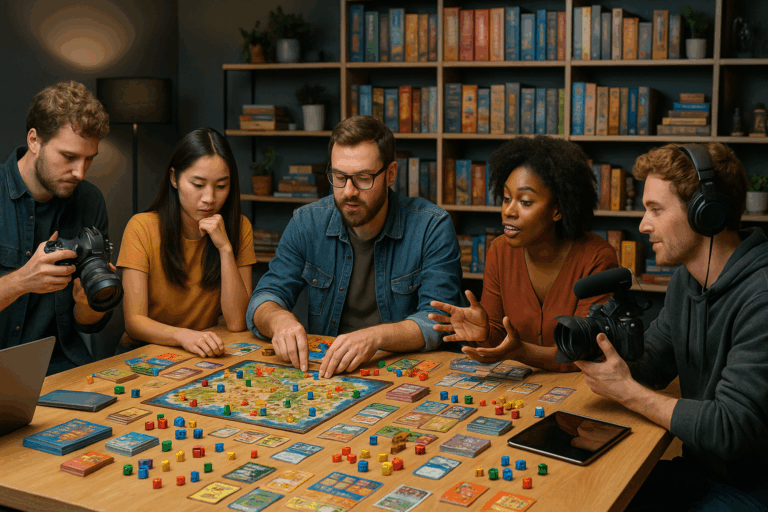The realm of video games, particularly, is one where the constant rush of creativity and innovation is as breath-taking as it is relentless. And within this world, every so often, a radical concept, a transformative idea, spirals up from the depths of this vortex, challenging the status quo, and forever altering the way we perceive, design, and experience video games. Yes, we are talking about viral game ideas – the game-changers, if you will – that have the potential to unlock unprecedented levels of engagement and fun.
Whether it’s the minimalist design and viral appeal of ‘Flappy Bird’, or the immersive augmented reality experience of ‘Pokémon Go’, viral game ideas have proven time and again, that they are not mere flashes in the pan, but significant pivot points in the gaming industry. They command attention, generate buzz, and more importantly, they drive engagement at a scale that is often hard to fathom, let alone replicate. 🎮
So, what makes these ideas tick? How can developers tap into this vast reservoir of potential and come up with their own viral game ideas? And perhaps most importantly, how can these ideas be translated into engaging, fun-filled experiences for the end-users? These are some of the questions we’ll explore in this article, aiming to shed light on the power of viral game ideas for maximum engagement and fun.
Whether you’re a seasoned game developer, an aspiring game designer, or simply an enthusiast eager to understand the inner workings of the gaming industry, this article will serve as your guide through the thrilling rollercoaster ride that is the world of viral game ideas. 🎢
Together, we will delve into the anatomy of successful viral games, exploring the factors that have propelled them to their soaring heights of popularity. We’ll also examine the role of creativity and innovation in driving virality, and how developers can effectively harness these elements to craft their own game-changing ideas.
Unpacking the Power of Virality
Let’s start by unpacking the term ‘virality’. It’s a term that has become ubiquitous in the digital age, often used to describe the rapid, exponential spread of information, ideas, or trends across the internet. But in the context of video games, virality is much more than just a measure of popularity. It’s a testament to a game’s ability to captivate audiences, engage players on a deep level, and create a sense of shared experience that transcends geographical and cultural boundaries. 🌍
Understanding this phenomenon is crucial for any game developer aiming to hit the viral jackpot. But, as we will see, achieving virality is no easy feat. It requires a perfect blend of innovative design, compelling gameplay, and an intuitive understanding of player psychology and preferences.
In the upcoming sections, we’ll dig deeper into these aspects, providing actionable insights and strategies to help developers formulate their own viral game ideas. We’ll also highlight some of the most successful viral games of recent times, drawing valuable lessons from their success stories.
So, buckle up, as we embark on this exciting journey into the world of viral game ideas, exploring their transformative power, and how they can be harnessed to create engaging, fun-filled gaming experiences that players will love. Game on! 🕹️
Decoding the Magic: Unveiling the Secret Behind Viral Game Ideas
Every game developer’s dream is to create a game that transcends boundaries and becomes a viral sensation. However, the secret behind viral game ideas is a mystery that isn’t easily unraveled. This enigma is a captivating mix of the right elements, including a fun and engaging game concept, high replayability, and social sharing potential, which when combined, create a perfect storm for maximum engagement and fun. The phenomenon of viral games is not just a product of chance; it requires careful design and an understanding of the psychology of fun.
The birth of viral games such as Flappy Bird, Pokemon Go, and Angry Birds have changed the landscape of the gaming industry, demonstrating that simplicity can indeed lead to popularity and that the elements of fun and engagement are key factors in determining the success of a game.
To further delve into the fascinating world of viral game ideas, let’s take a closer look at some of the key elements that define these gaming sensations. Understanding these elements could be the game changer in developing a viral game idea that captivates millions of players around the globe.
Element 1: Fun and Engaging Game Concept
The heart of any game lies in its concept. It’s the core idea that will attract players and keep them hooked. A fun and engaging game concept can result in countless hours of entertainment. This is often achieved by incorporating a unique and innovative game mechanic, a strong narrative, or a compelling world for players to explore.
Take, for instance, the viral game ‘Flappy Bird’. Its concept was incredibly simple, yet highly engaging. All you had to do was to navigate a bird through a series of pipes by tapping the screen. Despite its simplicity, it was fun, addictive, and had a high replayability factor, quickly leading it to become a viral sensation.
Therefore, when developing a game idea, focus on creating an engaging concept that is fun to play. The game should bring joy, challenge, and a sense of achievement to its players. Additionally, it’s crucial to ensure that your game concept is easy to understand and play. Games with complex controls or confusing concepts often struggle to find a broad audience.
Watch: ‘The Science of Fun: Game Design and the Four Keys to Fun’ (YouTube, Channel: Extra Credits)
Element 2: High Replayability
Replayability is another key factor in the creation of viral game ideas. Games that encourage players to play again and again often succeed in maintaining a high level of engagement. Replayability can come in various forms, such as new levels, goals, or rewards that players can achieve. The thrill of reaching a new high score or unlocking a new level or item can keep players coming back for more.
For example, the game ‘Angry Birds’ achieved a high replayability factor through its level design and scoring system. Players were encouraged to replay levels to improve their score and earn three stars. This simple yet effective mechanic ensured that players kept playing the game, leading to its viral success.
Another aspect of replayability lies in unpredictability. Games that are too predictable can quickly become boring. Incorporating elements of randomness or procedural generation can add a layer of unpredictability to your game, thereby increasing its replayability.
Watch: ‘Designing for Replayability’ (YouTube, Channel: GDC)
Element 3: Social Sharing Potential
The final element in creating viral game ideas is social sharing potential. In today’s digital age, the power of social media cannot be underestimated. A game that can be shared and played with friends or that encourages competition can rapidly increase its player base and engagement.
The game ‘Pokemon Go’ is a perfect example of this. It tapped into the power of social sharing by encouraging players to go out into the real world and catch Pokemon. Players could share their finds with friends, compete for control of gyms, and participate in community events. This social aspect contributed significantly to the viral success of the game.
Similarly, incorporating features that allow players to share their achievements, compete with others, or cooperate with friends can significantly increase the social sharing potential of your game. Not only does this make your game more fun and engaging, but it also provides free marketing for your game through word of mouth.
Watch: ‘Designing Social Gameplay – GDC 2018’ (YouTube, Channel: GDC)
Comparison of Viral Game Elements
Game
Fun and Engaging Concept
High Replayability
Social Sharing Potential
Flappy Bird
Simple and challenging gameplay
High score challenge
Competitive leaderboard
Angry Birds
Innovative slingshot mechanic
Levels and star rating system
Level sharing
Pokemon Go
AR-based real-world exploration
New Pokemon and locations
Multiplayer battles and events
By understanding and combining these elements of fun and engaging game concept, high replayability, and social sharing potential, you can create a viral game idea that not only provides maximum engagement and fun for the players but also stands the chance of becoming the next big sensation in the gaming world.
Watch: ‘Why Games Go Viral: A Game Out of Nothing’ (YouTube, Channel: Extra Credits)
ConclusionIn conclusion, we have journeyed through the intricate yet fascinating realm of technology, specifically focusing on the critical areas of Information Technology (IT) and Engineering. The article has unpacked complex concepts, using my knowledge and experience in Software Engineering to elucidate in a language that both the layman and expert can understand. The premise of this text was to showcase that even though technology may seem to be challenging and somewhat intimidating, its principles and concepts can be distilled into digestible chunks of information.
We commenced our exploration by delving into the nuances of Software Engineering, highlighting the importance of this field in today’s tech-driven society. The role it plays in the creation, development, and maintenance of software systems was thoroughly explored. It’s important to remember that, without software engineering, many of the applications and systems we use daily would be inefficient, unsecured, or even non-existent. As our society continues to depend more and more on software systems, the importance and relevance of software engineering will only continue to grow.
Moving on, we took a deep dive into the world of Information Technology (IT). In this section, we dissected the many facets of IT, with special emphasis on its influence on businesses and organizations worldwide. The integration of IT in various sectors has revolutionized the way businesses operate, making it a necessity in this digital age. It’s crucial to acknowledge that, whether it’s enhancing customer service, improving operational efficiency, or facilitating decision-making processes, IT is indispensable.
As we wrap up, I’d like to stress once again that understanding these intricate concepts is not an insurmountable task. With the right guidance and resources, anyone can grasp these ideas and even apply them in their personal or professional lives. It is my hope that this article has provided that guidance and sparked an interest in you to delve deeper into the world of technology.
I invite you to share your thoughts, questions, or comments about this article. How has it affected your understanding of IT and Engineering? Are there any specific topics you’d like us to cover in future articles? Your input is invaluable, as it helps shape our content to suit your needs. 😊
In the spirit of continuous learning, I urge you to apply the knowledge gained from this article in your daily activities. Whether you are an IT professional, an engineer, or just a curious individual, there is always something new to learn and a new perspective to gain. 💡
For further reading, I recommend visiting the following sites:
– Association for Computing Machinery
– Institute of Electrical and Electronics Engineers
– IEEE Computer Society
Remember, knowledge shared is knowledge multiplied. So, feel free to share this article with your friends, colleagues, or anyone who might find it helpful. 🚀
In the end, it’s all about breaking down complex barriers, encouraging collaboration, and fostering a culture of continuous learning. Let’s keep the conversation going! Until next time, happy reading, and exploring!
References:
1. ScienceDirect
2. ACM Digital Library
3. JSTOR
Originally written by Rodrigo Almeida
Leave a Comment



